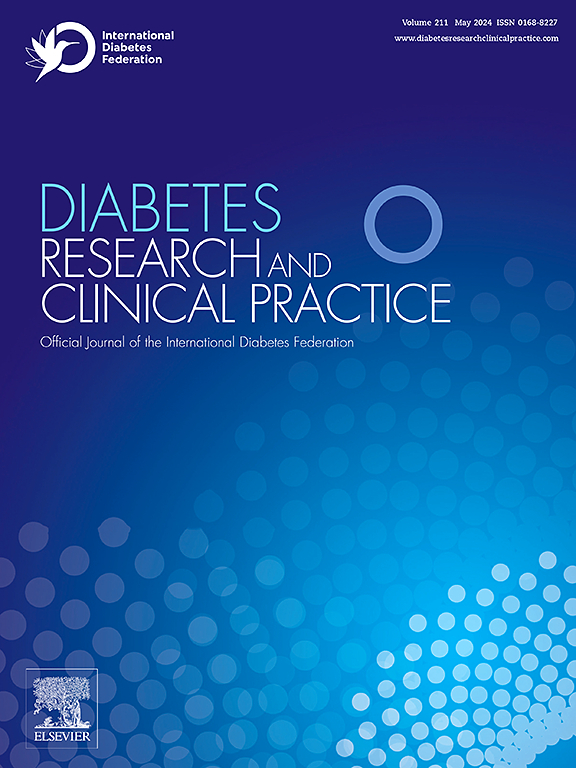1型糖尿病成人患者持续皮下注射或每日多次注射胰岛素的满意度
IF 6.1
3区 医学
Q1 ENDOCRINOLOGY & METABOLISM
引用次数: 0
摘要
背景糖尿病(DM)是一种慢性疾病,在世界范围内发病率呈上升趋势。本研究的目的是调查1型糖尿病(T1DM)患者目前使用多次每日注射(MDI)或连续皮下胰岛素输注(CSII)的胰岛素输送方法(INS)的满意度。此外,一个次要目的是使用回归分析测试选定变量对MDI或CSII患者满意度的影响。方法在捷克共和国摩拉维亚地区进行横断面研究。采用胰岛素输送系统评分问卷(IDSRQ)对197名T1DM患者进行定量分析,其中胰岛素输送与MDI或CSII至少持续1年。统计方法采用描述性统计、学生t检验和回归分析。结果CSII患者与MDI患者对目前INS给药方式的满意度有显著差异(p <;0.001),目前的分娩方法如何帮助患者维持稳定的血糖值,预防高血糖(p <;0.001),对目前INS交付方法的总体满意度(p <;0.001)。MDI和CSII的平均总体满意度分别为56.19分和62.08分。回归分析揭示了总体满意度的预测因子,即当前的INS提供方法如何帮助MDI患者(p <;0.01)。其他所选变量的影响尚未得到证实。结论本研究结果显示,CSII患者对INS给药方法总体满意度较高。目前的INS给药方法并不影响大多数患者的日常生活和活动。本文章由计算机程序翻译,如有差异,请以英文原文为准。
Satisfaction of adult patients using continuous subcutaneous insulin infusion or multiple daily injections with type 1 diabetes mellitus
Background
Diabetes mellitus (DM) is a chronic disease with prevalence increasing worldwide. The aim of this study was to investigate satisfaction with the current method of insulin delivery (INS) amongst patient with type 1 diabetes mellitus (T1DM) using multiple daily injection (MDI) or continuous subcutaneous insulin infusion (CSII). Furthermore, a sub-aim was to test the effect of selected variables on patient satisfaction with MDI or CSII using regression analysis.
Methods
A cross-sectional study carried out in the territory of Moravia in the Czech Republic. A quantitative approach using the Insulin Delivery System Rating Questionnaire (IDSRQ) among 197 respondents with T1DM with INS delivery with MDI or CSII for at least 1 year. Statistical methods used were descriptive statistics, Student’s t-tests and regression analysis.
Results
Highly significant differences were found between CSII and MDI patients in satisfaction with the current method of INS delivery (p < 0.001), in how the current method of delivery helps patients maintain stable blood glucose values, prevent high blood glucose (p < 0.001), and in overall satisfaction with the current method of INS delivery (p < 0.001). The average overall satisfaction score was 56.19 points for MDI and 62.08 points for CSII. Regression analysis revealed predictors of overall satisfaction on the mean score on how the current method of INS delivery helps MDI patients (p < 0.01). The effect of other selected variables was not confirmed.
Conclusion
The results of the study showed higher overall satisfaction with the method of INS delivery in CSII patients. The current method of INS delivery does not interfere with daily life and activities in most patients.
求助全文
通过发布文献求助,成功后即可免费获取论文全文。
去求助
来源期刊

Diabetes research and clinical practice
医学-内分泌学与代谢
CiteScore
10.30
自引率
3.90%
发文量
862
审稿时长
32 days
期刊介绍:
Diabetes Research and Clinical Practice is an international journal for health-care providers and clinically oriented researchers that publishes high-quality original research articles and expert reviews in diabetes and related areas. The role of the journal is to provide a venue for dissemination of knowledge and discussion of topics related to diabetes clinical research and patient care. Topics of focus include translational science, genetics, immunology, nutrition, psychosocial research, epidemiology, prevention, socio-economic research, complications, new treatments, technologies and therapy.
 求助内容:
求助内容: 应助结果提醒方式:
应助结果提醒方式:


